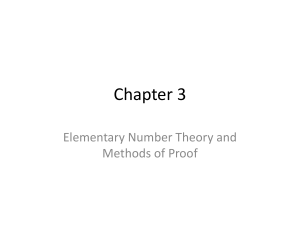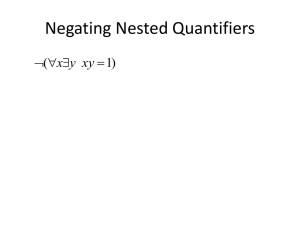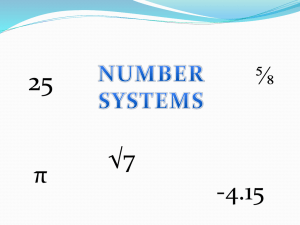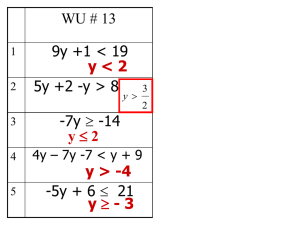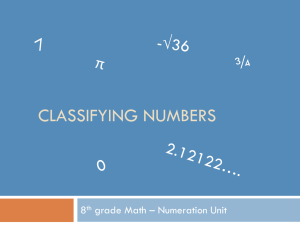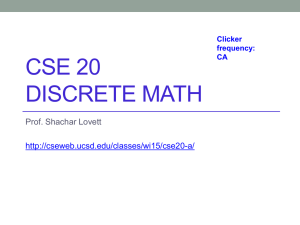Extremely rational proofs of irrationality
advertisement
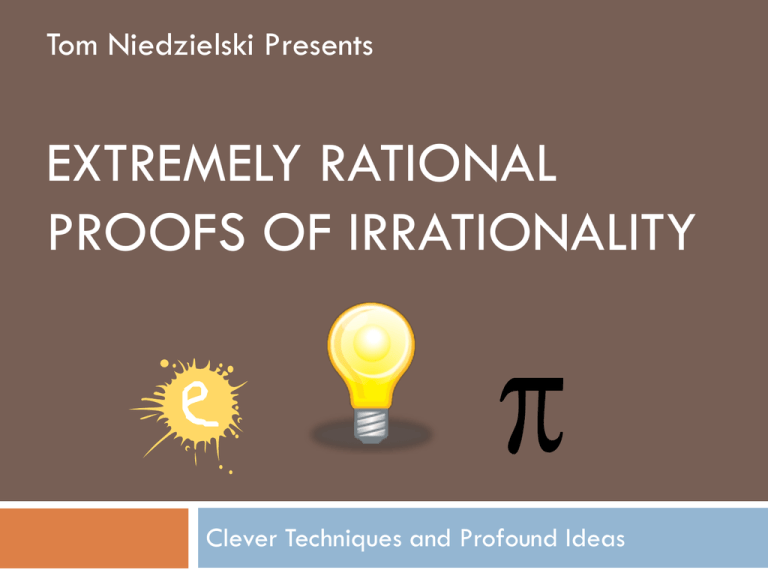
Tom Niedzielski Presents EXTREMELY RATIONAL PROOFS OF IRRATIONALITY Clever Techniques and Profound Ideas Topics to be Covered Joseph Liouville Proof: Irrationality of e Proof: Irrationality of e2 Charles Hermite Hermite’s Helpful Lemma Proof: Irrationality of π2 Summary Joseph Liouville (1822-1901) Life: Father was a captain under Napoleon Taught at many different institutions Public failures hurt him deeply Achievements: Most famous for number theory and Differential Equations Major works in transcendentals The Irrational Number e 1 e is. e = , which is n n 0 n! x x formula e = . It’s First, we’d better go over what derived from the more general n 0 n! used in many branches of mathematics, especially when describing exponential growth or decay. The easiest way to discover that e is irrational is to assume it is rational, and then look for a contradiction. The Irrational Number e So, assume e = a/b for integers a,b>0. To eliminate the RHS fraction, we multiply by n!b on both sides. Now we see n!be = n!a. n!a = an integer, as we’re only multiplying integers. n!be is more complicated. n 1 * , k 0 k! 1 * k , n 1 k! It breaks into bn! an integer, plus bn! 1 1 b ( which = n 1 (n 1)(n 2) ...). Fortunately, we can narrow down the range this converges to for large values of n. The Irrational Number e We compare b( n 1 1 (n 1)(1n 2) ...) to a few other values: b b b b b b b ... ... 2 3 n 1 n 1 (n 1)(n 2) n 1 (n 1) (n 1) n 1 1 ...) n 1 (n 1)(n 2) This shows that is trapped between the nearest rational values, and thus cannot be an integer. Of course, this means that the entire left hand side is not an integer. Since the right hand side is, the two cannot be equal. This is our contradiction. Therefore, e is irrational. b( Is 2 e Also Irrational? The previous techniques can be extended to e2. Again, we assume e2 = a/b. We then rewrite the equation as be = ae-1, and multiply by n! to get n!be = n!ae-1. As we discovered last time, n!be is just above an integer, coming from the right as n->∞. Let’s look at the other side. It also breaks down into integer and non-integer parts. Is 2 e Also Irrational? The non-integer part is 1 1 1 n+1 ...). (-1) n!a( (n 1)! (n 2)! (n 3)! In the case of even n, a 1 1 1 1 n+1 ( 1 ... -(a/n) < (-1) n!a((n 1)! (n 2)! (n 3)! ) < n 1 n ) < 0. Notice that for increasing even n, this value becomes a small negative number, making the RHS slightly lower than an integer. Since the LHS is slightly above an integer, they can’t be equal. This is our contradiction. Charles Hermite (1822-1901) Life: Born to a merchant family Deformity kept him out of wars, schools Taught from 1847 to 1897 Achievements: Proved e transcendental in 1873 Solved the general quintic in 1858 Discovered the Hermitian Forms A Very Useful Lemma x n (1 x) n n! For some fixed n ≥ 1, let f(x) = This function has three useful properties: 1 2n 1. f(x) is a polynomial of the form f(x) = n! ci xi i n 1 2. When 0 < x < 1, 0 < f(x) < n! 3. For all k ≥ 0, the derivatives f(k)(0) and f(k)(1) are integers. The third property results from the fact that f(k)(0 or 1) (where k ≥ 0) goes to 0 unless n ≤ k ≤ 2n, for which f(k)(0 or 1) is an integer. A Somewhat Simple Proof for π2 As in our proofs of e and e2, we begin by assuming the opposite of what we want to prove. Assume π2 = a/b for integers a,b > 0. This step is a little different: We now define the new function F(x) = bn(π2nf(x) - π2n-2f(2)(x) + π2n-4f(4)(x) …) F(x) has a useful feature: F’’(x) = -π2F(x) + bnπ2n+2 f(x) We’ll use this soon. A Somewhat Simple Proof for π2 Then we take a useful derivative: d [F’(x)sin(πx) – πF(x)cos(πx)] = F’’(x)sin(πx) + dx πF’(x)cos(πx) - πF’(x)cos(πx) + π2F(x)sin(πx) = sin(πx)(F’’(x) + π2F(x)) = bnπ2n+2 f(x)sin(πx) = bn(an/bn) π2f(x)sin(πx) = anπ2f(x)sin(πx). Now we’re going to use this information to define 1 another function: N = a n 0 f ( x) sin(x)dx . This in turn = 1 [ F ' ( x) sin(x) F ( x) cos( x)]10 = F(0) + F(1) = an integer. A Somewhat Simple Proof for π2 We also know that N is positive, since it is the integral of a positive region. a n Also, we know that N < n! . This is because for 0 < x <1, 0 < f(x) < 1/n!, and sin(πx) ≤ 1. Notice that large n will make na! < 1. Since no integers lie between 0 and 1, N can’t be an integer. N can’t both be and not be an integer, so we’ve found our contradiction. n A Somewhat Simple Proof for π2 Therefore, π2 is not a rational number. Note: When we work with irrationality proofs, though x irrational ≠> x2 irrational, x irrational => x is irrational. We can use this and the fact we just proved to conclude that since π2 is irrational, π is irrational. In Summary We have shown that e, e2, π, and π2 are all irrational numbers. In each of our cases, proof by contradiction provided a clean result. As mathematics advances, it is often beneficial to revisit old ideas to see if they can be handled better. Sources 1. 2. 3. 4. Proofs from The Book, Chapter 6 (Proofs) http://www-groups.dcs.stand.ac.uk/~history/Biographies/Hermite.html (Hermite’s Biography) http://www-groups.dcs.stand.ac.uk/~history/Biographies/Liouville.html (Liouville’s Biography) Dr Biebighauser (Advice on Design & Content)



